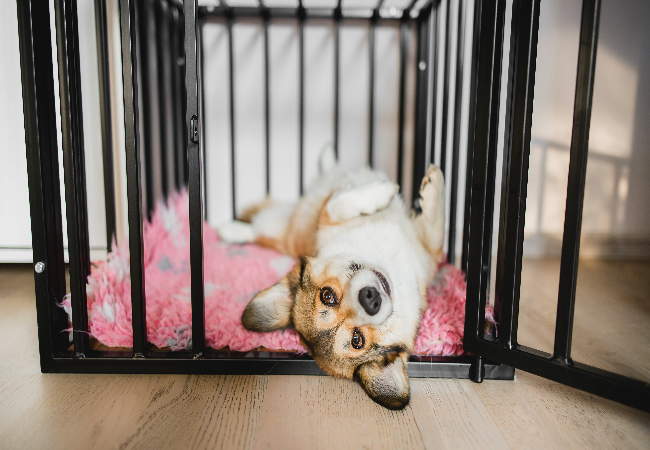Surviving Puppy’s First Night 2025: Vet Tips for Comfort & Connection 🐶🛏️

In this article
Surviving Puppy’s First Night 2025: Vet Tips for Comfort & Connection 🐶🛏️
By Dr. Duncan Houston BVSc
Bringing home a puppy is thrilling—but the first night can feel overwhelming as your pup adjusts to a new environment and separation from littermates. With proactive planning, empathy, and calm routines, you can ease both your minds and lay the foundation for trust. Here’s your veterinary roadmap to help your puppy—and you—sleep soundly. 💤
1. 🏠 Prep the Crate as a Cozy Den
Dogs are den animals—it’s natural they seek covered, enclosed spaces for safety.
- Use a crate with comfy bedding, breathable cover, and a heartbeat toy or ticking clock to mimic littermates.
- Never use the crate for punishment—feed meals inside it, keep toys there, and build a positive association.
- Start with the crate placed in your bedroom so your puppy senses your presence.
2. 🍽️ Plan Dinner & Potty Before Bed
Feed your puppy at about **5 p.m.**, giving time to digest and eliminate before sleep.
- Take puppy out right after dinner, and again as bedtime approaches.
- Expect to take them out during the night—puppies (8–10 wks) typically need breaks every 4‑6 hrs overnight.
3. 🎾 Tire Them Out, Then Calm Down
Evening play and mental games help—but wind-down is vital to prevent over-excitement.
- Between 7–8 p.m., enjoy gentle play: puzzle toys, training, scent games.
4. 🌙 Establish a Calming Bedtime Routine
- Set a consistent bedtime—use a quiet tone like “night-night”.
- Sit by the crate until they settle, then quietly leave the room.
- If they cry, wait up to 10 minutes—if still distressed, offer silent reassurance and another potty break.
5. 🚽 Middle-of-Night Potty Protocol
- Respond quietly and calmly—no playtime, just a short walk.
- Reward with praise and back to crate—no toys or fuss.
- Use **Ask A Vet** app anytime you’re unsure if it’s fear-based or real need.
6. 📏 Set Boundaries & Space Rules
- Restrict initial access to puppy-safe zones only—no full house freedoms.
- Establish where they sleep long-term—bedroom vs separate area—and maintain consistency.
- Use baby gates to prevent overstimulation or access to hazards.
7. 🐾 Breed & Age Considerations
- Small breeds: more frequent potty breaks due to small bladders; plan intervals more often.
- Brachycephalic puppies: may need more soothing and slower wind-down due to airway sensitivity.
- High-energy breeds: longer playtime early evening, then gradual quieting with puzzle games to prevent boredom-induced crying.
8. 👃 Comfort with Familiar Smells
Include one of your worn t-shirts in the crate—your scent is incredibly calming.
Heartbeat toys can mimic littermate presence and soothe anxiety.
9. 🧠 Build Crate Positivity
- Leave toys and chewables in the crate during the day.
- Feed meals and treats in the crate so it remains a cozy retreat.
- Introduce the crate gradually—not at bedtime only.
10. 🛡️ Responding to Tears & Whines
- Differentiate between anxiety cries (early night) and potty signals (late night).
- For anxiety cries: quiet reassurance, cover crate briefly, compassionate tone, avoid overstimulation.
- For potty cries: respond, quick potty break, silent return.
11. ✅ First Morning: Set the Tone
- Take puppy out immediately upon waking—reward success enthusiastically.
- Stick to your planned feeding-pottie-play schedule.
12. 🛠️ Overnight Gear & Player Checklist
- Heartbeat Toy: mimic litter comfort during night
- Ask A Vet App: instant support and peace of mind
- Night light & ticking clock: gentle sensory comfort
13. 🛌 Handling Crate Aversion or Regression
- If puppy resists crate: reintroduce gradually—treats inside, short sessions during day.
- Slowly increase crate time with positive associations.
- If whines persist beyond a week, reassess the environment, routine, or consider consulting a certified trainer or behaviorist.
14. 🧩 Long-Term Sleep & Independence
- Once toilet training is established, move the crate gradually to the permanent location—keep bedding and routines consistent.
- Encourage quiet independence with comfort tools, but avoid co-sleeping on your bed—can cause separation and hygiene issues.
- Allow the crate to be sanctuary through life changes and travel.
15. 📚 Owner & Puppy Readiness Tips
- Clear your schedule for at least the first 3 nights—less stress, better bonding.
- Puppy-proof your environment before they arrive.
- Prepare necessary supplies: crate, bedding, food/water bowls, cleaning wipes, treats, light toys.
- Line up your vet for first check-up within 2–3 days of arrival.
📌 Key Takeaways
- Your puppy is anxious and adjusting—compassion, structure, and consistency make a difference.
- Create a peaceful crate environment that becomes a trusted den.
- Plan pre-bedtime potty, calm play, cozy bedding, and expect occasional night breaks.
- Use comforting scents, heartbeat toys, and positive tone for reassurance.






